Answered step by step
Verified Expert Solution
Question
1 Approved Answer
We want to run BFS on very large graphs, where we can't store the whole graph upfront, but where only the neighbours of a vertex
We want to run BFS on very large graphs, where we can't store the whole graph upfront, but where only the neighbours of a vertex are shown at a time, using some form of unique identifier. How can we modify BFS to handle such situations used for example for crawling the Internet while still maintaining efficiency?
We want to run BFS on very large graphs, where we can't store the whole graph upfront, but where only the neighbours of a vertex are shown at a time, using some form of unique identifier. How can we modify BFS to handle such situations used for example for crawling the Internet while still maintaining efficiency?
One just ignores whether one has already seen a vertex or not; so the memory of the algorithm just keeps the current neighbourhood in mind so to speak
This can not be done, but BFS needs to see the whole graph from the beginning.
An appropriat dictionary is to be used, where all seen vertexids are stored. In the loop where all neighbours of a vertex are scanned, those which are already in the dictionary are ignored, while the others the new ones are entered into the dictionary. The objects stored in the dictionary consist of the id plus the distancevalue and the parentpointer.
One keeps a list of vertexids seen. When scanning the neighbours of a vertex, one checks in the list whether one has already seen the neighbour in which case the neighbour is ignored while otherwise one adds the new vertex to the list with information on distance and parent
Step by Step Solution
There are 3 Steps involved in it
Step: 1

Get Instant Access to Expert-Tailored Solutions
See step-by-step solutions with expert insights and AI powered tools for academic success
Step: 2

Step: 3

Ace Your Homework with AI
Get the answers you need in no time with our AI-driven, step-by-step assistance
Get Started


